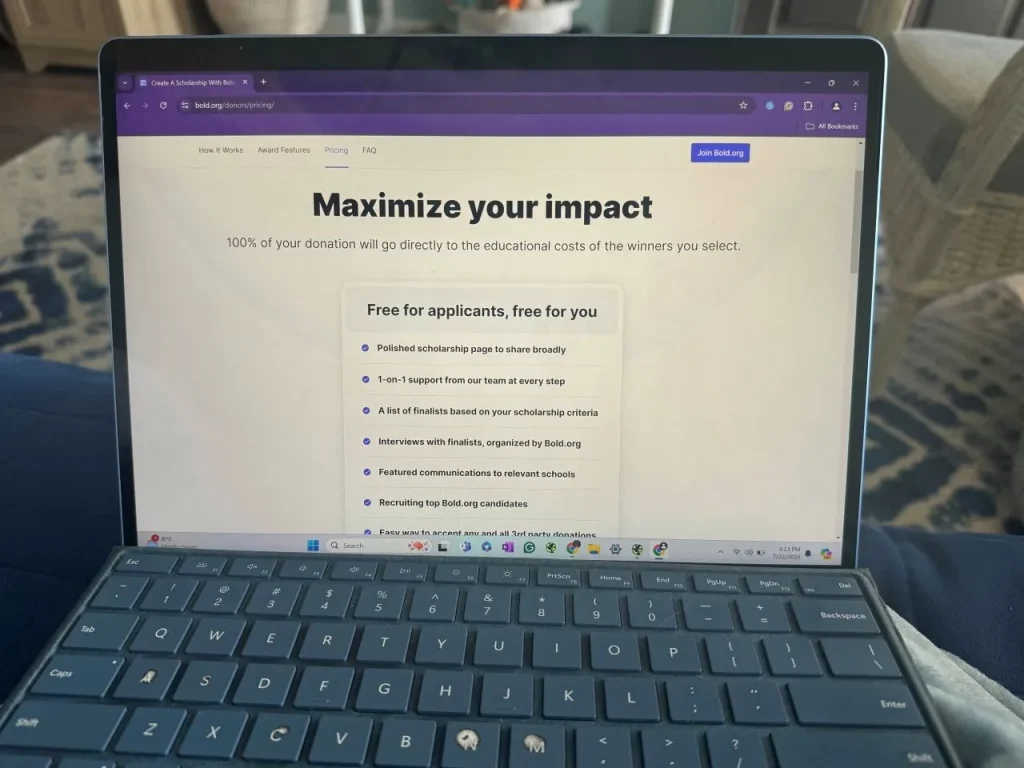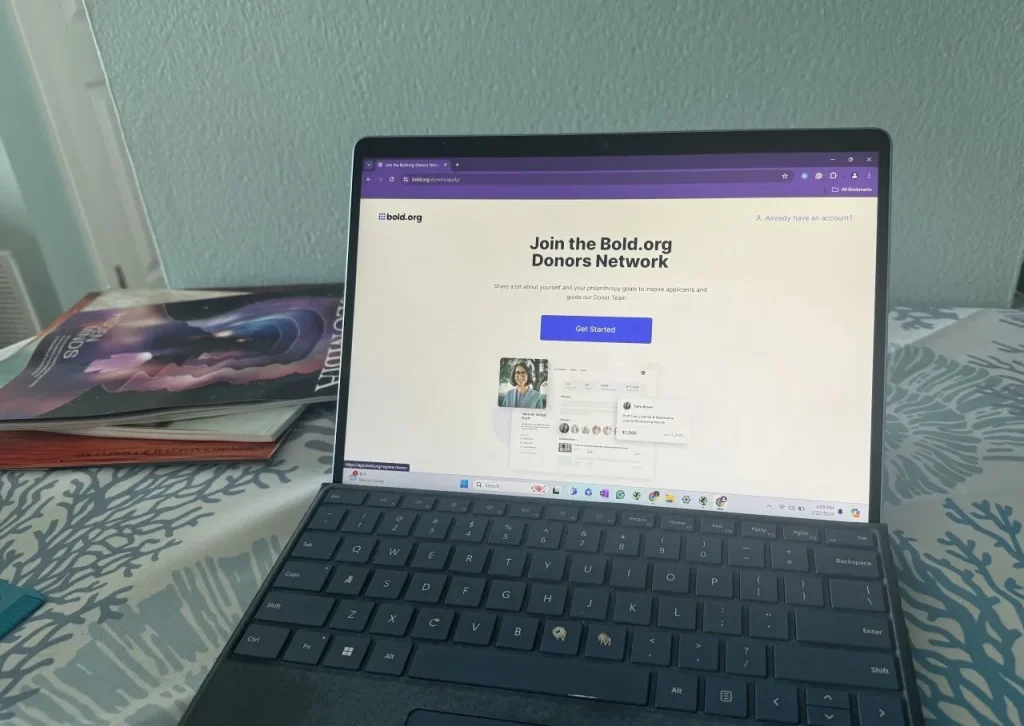How to Start a Scholarship Fund in 5 Easy Steps (2024)
Have you ever wondered how many dreams are left unfulfilled due to the high cost of education? Imagine being the person who makes education accessible for someone, changing the trajectory of their future. By starting a scholarship fund, you can become that catalyst for change.
Scholarships are more than just financial aid—they are influential resources that transform lives.
As a graduate of a private university facing substantial student loan debt, I understand the profound relief scholarships can provide. During my studies, scholarships were a tremendous help, covering part of my tuition and easing some of the stress. Creating a scholarship fund is more than just a donation; it’s an amazing gift that truly makes a difference.
I know firsthand how scholarships can help students pay not only their tuition but also books, supplies, rent, food, and even help pay back student loans. By starting a scholarship, you provide a deserving student the chance to meet their educational goals.
Starting a scholarship fund is a remarkable way to give to those in need, to those who do not have the opportunities otherwise, like me. As a first-generation college student, scholarships helped me become the first in my family to break the cycle of poverty. If there were more scholarship opportunities, more students could afford college without having to rely heavily on student loans, just like I did, and more students could change their lives.
Setting up a scholarship on your own can be a bit complex, and I get it. Going through the process of creating a tax-exempt foundation and providing documentation to the IRS can seem a bit intimidating. Luckily, there are scholarship organizations that manage all the paperwork for you, like Bold.org. These organizations offer support by collecting donations for your scholarship awards, drafting your scholarship, advertising your scholarship, and helping review applications and choose a deserving recipient.
I’ve compiled everything you need to know to create a scholarship fund, including the IRS guidelines for tax deductions, all in one place. Let’s jump in!

Scholarship Creation Options
Utilizing Bold.org
- Pros: Easy setup at no cost, administrative support, compliance assurance, direct involvement
- Cons: Minimum of $500 to start
Set Up a Foundation Yourself
- Pros: Build a legacy, growth potential
- Cons: Complex setup, high cost, regulatory compliance, resource-intensive
Pay a Scholarship Management Service
- Pros: Time-saving, compliance assurance
- Cons: Dependency, less involvement, high cost, limited transparency
What You Need to Know About Scholarship Funds
A scholarship fund is a charitable donation designed to help students pay for educational expenses, including tuition, room and board, books, supplies, etc. You can create a scholarship fund for students at any grade level, and many donors choose to keep their scholarships open to all students. The greatest thing is that you can choose who you wish to support!
An added bonus for donors is that scholarships are 100% tax-deductible! That’s right. If you create a generous scholarship, the amount you donate is tax-deductible. It’s a win-win for both the student and the donor.
One important note: to qualify for tax-exempt status with the IRS, your scholarship must be awarded on an objective and nondiscriminatory basis. Ensure your scholarship follows IRS guidelines to maintain its tax-deductible status. Don’t worry, I cover this soon.
How to Start a Scholarship Fund
If you plan to establish the scholarship yourself, you’ll need to create a private foundation and submit the proper paperwork to the IRS. Getting approval from the IRS is essential to secure tax-exempt status.
You first need to determine which type of foundation you wish to establish. The IRS recognizes many tax-exempt organizations, and scholarship funds typically fall under grant-making foundations.
Next, you’ll need to ensure your foundation meets the requirements necessary to apply for tax-exempt status and gather all required legal documents. You’ll need to file registration paperwork with your state and the federal government.
This process can differ based on the type of organization, the size of the foundation, and the scholarship fund amount. Creating a scholarship on your own can be quite time-consuming and expensive. You’ll need to hire a lawyer and a financial advisor to ensure you complete the paperwork correctly and meet all the necessary requirements, pay for website costs, and deal with various legal fees.
Considering setting up a scholarship fund? Scholarship management services like Bold.org can simplify the process and ensure your contributions make the greatest impact. Not only does the Donor Team at Bold.org help you get the best tax benefits, but the site is also super easy to use. Plus, you can create a scholarship for free, which means all your money goes straight to the students who need it rather than spending it on starting a foundation. Curious to learn more? I recommend contacting Bold’s Donor Team.

Is a Scholarship Fund Tax-Deductible?
When creating a scholarship fund, the IRS stipulates that grants or scholarships to individuals are tax-deductible if the following conditions are met:
- The scholarship is awarded on an objective and nondiscriminatory basis under a procedure approved in advance by the IRS. This means your eligibility criteria for your scholarship should be inclusive enough to ensure that scholarship recipients qualify as members of a charitable group.
- The scholarship is either:
- a scholarship or fellowship that is used for study at an educational institution. This means direct educational costs like tuition expenses, fees, course materials, etc.
- a prize or award that is excludable from gross income under Internal Revenue Code section 74(b). The recipient must be chosen from the general public, and they can keep the prize or award themselves.
- or to achieve a specific objective, produce a report, or improve a literary, artistic, musical, scientific, teaching, or similar capacity, skill, or talent of the grantee. This means your scholarship helps a student accomplish a specific goal, create a report, or enhance their abilities in these areas or similar fields.
Company scholarship programs are held to the same standards as scholarships to individuals and are taxable expenditures unless they meet the above requirements. Further, the IRS provides additional guidance for company scholarship programs on its website.
Proper documentation and adherence to IRS guidelines are necessary for scholarships to be considered tax-deductible, and the scholarship should further a charitable purpose as defined by the IRS to qualify for tax-deductibility. This is why platforms like Bold.org are super helpful in ensuring your scholarship meets IRS guidelines. For even more information, check the IRS website.
Tax Perks for Starting a Scholarship Fund
If you follow the IRS guidelines above or partner with a scholarship organization, the money you contribute to your scholarship fund will be tax-deductible.
You can also accept tax-free donations from other people who wish to donate to your scholarship fund.
From Start to Finish: Creating a Scholarship Fund
1. Determine Your Scholarship Budget
First, you need to know how much you want to dedicate to your scholarship fund. This is a great time to consider if you’ll accept donations from others to support your scholarship(s).
You do not need to spend thousands to create a scholarship. Working with a scholarship management service like Bold.org allows you to create a scholarship as low as $500.
Keep in mind that starting a nonprofit organization or private foundation independently can be costly. You’ll need to cover legal fees, advertising expenses, and the significant investment of time and money in building a website. Ask yourself, would you rather spend your funds on administrative fees or directly help more deserving students?
P.S.: If you didn’t know, Bold.org is an established, tax-exempt organization. Any scholarships you create utilizing Bold.org will be classified as tax-deductible donations to the Bold Foundation, 501(c)(3) non-profit. Plus, creating your scholarship on Bold doesn’t cost a thing!
As you plan your scholarship fund budget, decide on the kind of scholarship you wish to offer: a one-time award, a renewable scholarship, or an annual scholarship. The options are in your hands!
2. Identify Your Ideal Scholarship Awardee
After deciding on a budget, it’s time to identify who you wish to support.
Decide if you want to support students who have reached specific academic milestones or maintained a certain GPA. This way, your scholarship can celebrate and encourage hard work and academic dedication.
Think about the fields of study you’re passionate about. You might choose to help students pursuing majors that match your interests or are in high-demand career fields.
Additionally, think about supporting nontraditional students or first-generation college students. They could benefit greatly from the financial assistance your scholarship provides. You might also focus on students with significant financial need or those from specific demographics.
Ultimately, the choice is yours! Your scholarship can make a meaningful impact in an area you care about most.
Remember: No matter who you wish to help, it’s important to make sure your scholarship is nondiscriminatory.

3. Craft Scholarship Eligibility Criteria
When you’re crafting scholarship eligibility criteria, think about various aspects to ensure your scholarship effectively supports the students you aim to help. Here’s a guide to get you started:
Academic Achievement
- Ideas:
- Set a minimum GPA requirement (like a 3.0 or higher).
- Require the completion of specific academic milestones, such as finishing junior year or a certain number of credits.
Field of Study
- Ideas:
- Focus on specific majors or fields, like STEM, arts, education, or healthcare.
- Choose high-demand career fields or areas with skill shortages.
Financial Need
- Ideas:
- Look for demonstrated financial need through FAFSA or other financial aid forms.
- Set specific income thresholds for applicants’ families.
Demographics and Background
- Ideas:
- Support nontraditional students, such as returning adults or part-time students.
- Focus on first-generation college students or those from underrepresented groups.
Personal Qualities and Extracurricular Involvement
- Ideas:
- Look for demonstrated leadership, community service, or extracurricular involvement.
- Ask for personal statements or essays on themes like overcoming adversity or career goals.
Geographical Restrictions
- Ideas:
- Target students from a specific city, state, or region.
- Focus on those attending a particular school or university.
By thinking through these aspects, you can create a scholarship that aligns with your values and goals while providing meaningful support to students who need it most.
4. Wrap Up Your Paperwork
Once you’ve figured out who you want to help with your scholarship and figured out the eligibility criteria, it’s time to get it set up! Here are three main ways you can create a scholarship fund:
- Start Your Own Nonprofit
- If you want full control, you can start your own nonprofit organization. Just a heads-up, though—this is the most expensive and time-consuming route. You’ll need a lawyer and a professional website, and be prepared for some hefty legal fees.
- Create an Endowed Scholarship
- Another option is to make a significant donation to a specific school or university to create an endowed scholarship. Keep in mind that many institutions have minimum donation requirements, so this path is generally for those with substantial financial resources.
- Use a Scholarship Management Organization
- The easiest and most cost-effective way is to partner with a scholarship management organization like Bold.org. They take care of all the administrative work, legal stuff, and even the advertising. Plus, setting up a scholarship on Bold.org is free! You’ll also get access to their expert team and a huge database of students.
Choose the option that fits your situation best, and you’ll be well on your way to making a real difference in students’ lives!

5. Setting up Your Scholarship
You”ll need to choose a name for your scholarship, an application deadline, and file documents with your state or federal government if you opt for your own foundation.
IRS Application
You’ll need to get approval on your selection and award procedures. This means you’ll have to write everything out in detail. If you’re planning to have a selection committee, it’s helpful to create clear guidelines and documents for the members to follow while reviewing applications.
Accepting Outside Donations
If you want to accept donations from others for your scholarship, you’ll need to handle the necessary paperwork to provide tax documents to your donors. As a private foundation or nonprofit, keeping specific records for government compliance is a must.
How to Reduce Paperwork and Simplify the Process
Using an established scholarship platform like Bold.org can make your life a lot easier by cutting down on the paperwork. When you create a scholarship with an existing nonprofit, you avoid the hassle of:
- Setting up your own foundation
- Handling tax paperwork for your donors
- Legal fees and compliance issues
Bold.org takes care of all the behind-the-scenes work for you. This way, you can focus on the rewarding part—helping students—without getting bogged down by administrative tasks. I definitely recommend this option!

Advertise Your Scholarship
Getting the word out about your scholarship is key to attracting great applicants. With your own private foundation or nonprofit, you would need to develop an advertising plan to make potential recipients aware of:
- The award
- The application requirements
- The deadline
If you create your scholarship with an online scholarship platform, it handles all the advertising for you. What a relief!
Choosing a Winner
Selecting your scholarship winner is an important step and the most exciting!
If you leverage a scholarship management service, this step will be super easy. For example, at Bold.org, their team supports you in the section process by reviewing applications on an ongoing basis and providing a list of the top 10-50 applicants. From there, you decide who the scholarship recipient is. Once you’ve chosen, they’ll notify the student and take care of sending the funds.
Donor Rewards for Creating a Scholarship Fund
One of the most rewarding aspects of gifting scholarships is the profound impact it has on students’ lives. As I mentioned earlier, scholarships made it possible for me to afford my education. Without them, attending college would have been out of reach.
By creating scholarships, you open doors for students like me—first-generation, nontraditional, and in need of financial support.
You also benefit financially by receiving tax deductions on the scholarship money you donate. By establishing a scholarship, you make a lasting impact, creating a ripple effect that benefits future generations. So, make a difference today! Who knows, you may be supporting the next great leader, innovator, or changemaker who will go on to make significant contributions to society.
How Much Money Do I Need to Start a Scholarship Fund?
The amount of money needed to start a scholarship fund can vary widely depending on the type and scope of the scholarship you wish to create. Here are some general guidelines:
- Minimum Requirements: Some organizations allow you to start a scholarship with as little as $500 to $1,000.
- Endowed Scholarships: If you want to create an endowed scholarship, which is a permanent fund where only the interest is used to award scholarships, you’ll typically need a larger sum. Endowed scholarships often require a minimum of $10,000 to $25,000, though some institutions may require more, typically around $50,000 or more, to ensure a sustainable fund.
- Administrative Fees: Keep in mind that managing a scholarship fund can incur administrative fees, which might be a percentage of the fund or a flat rate charged by the managing organization.
- Annual Scholarships: If you prefer to fund scholarships annually rather than creating an endowment, you can decide on an amount that fits your budget and goals. For example, you could set aside $2,000 annually to be awarded to one or multiple students.
- Partnering with Organizations: Some donors choose to partner with an educational institution, community foundation, or nonprofit that already has scholarship programs in place. These organizations can often help manage the fund and ensure that it is awarded according to your criteria.
Ultimately, how much you need to start a scholarship fund depends on your financial situation, your goals for the scholarship, and the guidelines of any organization you partner with. If you use Bold.org, you can start a scholarship with just $500, and every dollar goes directly to the scholarship. There are no fees or additional costs from Bold.org, and you’ll get plenty of support throughout the process!

FAQs on Scholarship Funds
Can anyone start a scholarship?
Yes. You don’t need to create a nonprofit or run a business to set up a scholarship.
How do I start a nonprofit scholarship fund?
You can start a scholarship and fund it yourself, but another option is to create a nonprofit scholarship fund that allows others to donate. This process can be complicated, and the exact steps depend on your state laws for starting and running a nonprofit.
If you want to give others a chance to donate to your scholarship without the extra steps of creating a nonprofit yourself, you can go through a scholarship management organization like Bold.org. You don’t have to pay any extra fees, and the platform handles all the administrative work of managing your fund and accepting donations.
How to start a scholarship fund in memory of someone?
Starting a memorial scholarship fund is similar to starting any kind of scholarship program. You’ll need to determine how to fund and manage the award and establish the criteria. If you plan to accept donations to fund the scholarship, decide if you want to set up the fund at a nonprofit or at your bank. Don’t forget to discuss potential tax issues with a financial advisor.
Ready to create a scholarship? Head over to Bold.org and begin your scholarship creation process today!
Our Editorial Team, with a rich background in educational content creation, prioritizes accuracy and quality in every article. We are committed to producing expert content tailored to meet the academic needs of college and high school students, ensuring they receive well-researched and trustworthy information for their educational journey.






